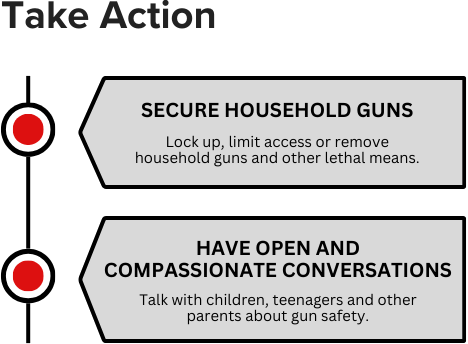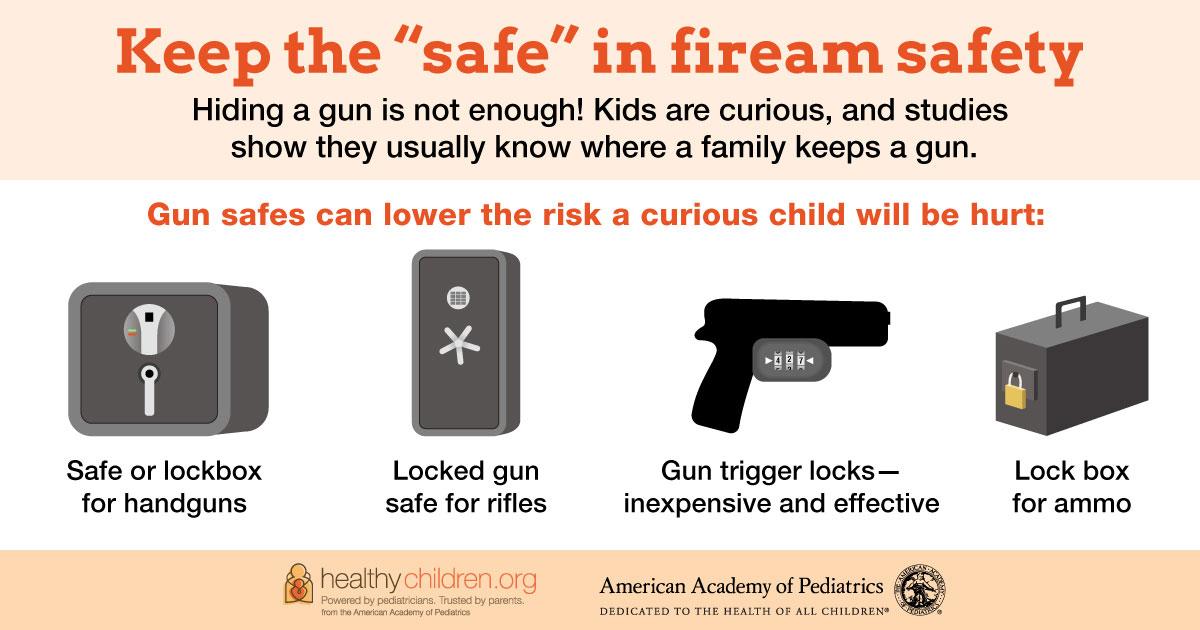Gun Injuries Are a Frequent and Serious Public Health Issue in Anne Arundel County
More than 200 individuals sustain a gun injury in the United States every single day. Of those who survive a gun injury, often adolescents and young men, many suffer from lifelong physical complications and trauma. Between 2020 and 2022, the most common cause of gun-related injury among Anne Arundel County residents under 19 years old was accidental discharge, accounting for 52.1% of cases, followed by assaults at 44.7%.
Guns Are a Leading Cause of Injury and Death Among Children and Teens
In the United States, nine children and teens die due to gun violence every day. For every fatality, an estimated five youth are injured by a gun. Each year, nearly 350 children gain access to a gun, most often in their home or that of a friend or relative, and unintentionally shoot themselves or someone else. Guns are the top leading cause of death among children and teens in Maryland. In 2022 in Anne Arundel County, 13% of all police reported gun incidents involve a victim under 18 years old. Out of these incidents, youth made up 3.3% of reported injuries.
Gun Injuries and Unintentional Shootings are Preventable
The resources on this page are intended for adolescents seeking resources and support. Parents and caregivers can also use the information in this toolkit to learn more about what they can do to make their homes and communities safer, and how to talk about gun safety with children, teens and other parents.

Free and confidential resources are available for teens to seek crisis counseling, mental health support, or just talk to someone.
Your Life Your Voice connects teens in need of help with crisis counselors. Call 1-800-448-3000 or text VOICE to 20121 24/7.
Teen Line connects teens who need someone to talk to with other trained teens available to listen and share options for help and support. Call 800-852-8336 or text TEEN to 839863.
The Trevor Project provides crisis intervention and suicide prevention services to LGBTQ individuals under age 25. Call 1-866-488-7386, text START to 678-678, or chat with a counselor 24/7.
The Crisis Warmline is available to all community members of Anne Arundel County. Staff are available 24/7 to offer information, support and referrals. Call 410-768-5522.
The Maryland Youth Crisis Hotline is available to adolescents by phone or chat 24/7. Call 800-422-0009 or chat with a trained professional.
It is the responsibility of caregivers to ensure that household guns are securely stored to prevent children, grandchildren, friends or other children and teens from gaining access.
Lock Up: Use a gun lock or safe to securely store guns. Keep guns unloaded and store ammunition separately.
Limit Access: Make sure children and teens do not have access to keys or combinations to locked guns.
Transfer: Consider temporarily storing your guns with a trusted individual outside of your home, especially when children or teenagers may be present.

Learn more about gun locks, boxes or safe options that match your needs while keeping children and teens safe.
Maryland's Child Access Prevention Law states that a person may not store or leave a loaded gun in a location where the person knew or should have known that an unsupervised child would gain access to it.
Safe storage of guns in households where children live and play can prevent unintentional injuries. Around 5.4 million children in the United States currently live in households where at least one gun is loaded and unlocked. Researchers estimate that if even half of those households were to lock up all of their guns, the lives of hundreds of children and teens would be saved each year.
Free gun safety kits are available by contacting the following departments:
- Anne Arundel County Police Department
- Anne Arundel County Sheriff's Office
- Annapolis Police Department
Adolescents are smart and curious. In studies about gun accessibility, almost half of teens reported knowing where and how to access a household gun. This occurred even among parents who believed otherwise. Of parents who believed their child could not gain access, one-third of their children reported knowing how to access or had previously handled a household gun. Teens are not the only ones capable of handling a gun. Children as young as three are strong enough to pull the trigger of a handgun.
In this short video clip, the Utah Suicide Prevention Coalition shares the importance of safe storage to prevent teen suicide. In Maryland, gun suicides are a leading cause of death among adolescents ages 15-19 at a rate of 8.3 out of 100,000. In the United States, young people have the fastest growing rate of gun suicides.
To learn more about suicide prevention in Anne Arundel County, visit our Suicide Prevention Toolkit.
In the same ways that we use safety practices for other situations, such as safe storage of cleaning products or pills, use of age-appropriate car seats, or pool and trampoline fencing, there are steps that caregivers can take to prevent unintentional shootings among children and teen suicides.
Safe storage of harmful household items including firearms is an important first step to preventing unintentional injuries or death among youth, including teen suicide. Caregivers should also familiarize themselves with how to have open and compassionate conversations with children, teens, and other parents about gun safety.
Talking with Children and Teens about Gun Safety
While sometimes tough or uncomfortable, caregivers should invite open and authentic conversations with children and teens about mental health and suicide. Resources are available to guide you through those conversations.
- #RealConvo from the The American Foundation for Suicide Prevention provides tools, resources and creative ways to have conversations about mental health with children and other loved ones. Learn more here.
- Be SMART is an educational campaign from the Everytown for Gun Safety Support Fund that offers resources for normalizing conversations about gun safety for kids. Learn more here.
Learn more about the Be SMART campaign from a local chapter leader of Moms Demand Action:
Talking with Other Parents about Gun Safety
In the same ways that we might talk about allergies with friends, family and other parents, caregivers should ask about guns and gun storage in households where their children go to play.
- Marylanders to Prevent Gun Violence created a Child Access Prevention Pamphlet with guidance on safe storage and how to talk to pediatricians and other parents about gun safety.
- The Children's Hospital of Philadelphia prepared a one-page Gun Safety Tip Sheet for parents and caregivers. Use the QR code on the tip sheet to watch a short video on proper gun safety and storage.
Watch this short video about how to talk with kids about gun safety from Project ChildSafe:
Sandy Hook Promise Learning Center
The Learning Center offers several trainings for students, educators and parents that teach youth and caregivers how to recognize the warning signs of someone who may be at risk of harming themselves or others. Included are free trainings, resources, and curriculum available for multiple age groups. Learn more here.
- The Start With Hello program is designed for grades K-12.
- The Say Something program for grades 4-12.
- The Say Something Anonymous Reporting System (SS-ARS) is a resource available to educators and school personnel for students to make anonymous reports.
Data Sources:
- National gun injury data:
- Everytown for Gun Safety: A More Complete Picture: The Contours of Gun Injury in the United States
- CDC: Firearm Violence Prevention Fast Facts
- CDC. 2020. “Nonfatal Injury Reports 2000-2018.” Accessed using WISQARS. http://www.cdc.gov/injury/wisqars/nonfatal.html Calculations by Children’s Defense Fund
- 2021 State of America’s Children report
- Kaufman, E.J., Wiebe, D.J., Xiong, R.A., Morrison, C.N., Seamon, M.J., Delgado, M.K. Epidemiologic Trends in Fatal and Nonfatal Firearm Injuries in the US, 2009-2017. JAMA Intern Med. 2021;181(2):237–244
- Fowler, K.A., Dahlberg, L.L., Haileyesus, T., Gutierrez, C., and Bacon, S. Childhood Firearm Injuries in the United States. Pediatrics. 2017; 140(1)
- Local gun injury data:
- Annual gun injury hospital data from the Health Services Cost Review Commission Outpatient Discharge and Inpatient Admissions data files (2020-2022)
- Anne Arundel County and Annapolis City Police Department's gun incident report data (2016-2021)
Toolkit Resource Sources:
SUPPORTING DOCUMENTS
- Asking About Secure Gun Storage
- Asking About Secure Gun Storage En Español
- Gun Injury Postcard
- Gun Injury Postcard En Español
- Gun Safe Storage
- Gun Safety Tip Sheet
- Gun Storage For Your Lifestyle
- MDH Youth Suicide Prevention Toolkit
- MDH Suicide Prevention Toolkit 2021
- Prácticas de Almacenamiento Seguras
- Real Convo Guide
- Real Convo Guide En Español
Stay Informed
Get notified on upcoming engagements and the latest project related news.


